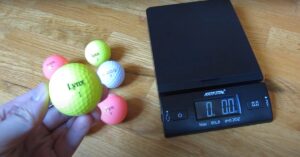Why Do Golf Balls Have Numbers On Them? Decoding the Secrets
When you step foot into a golf pro shop or browse online for golf balls, you might notice an array of numbers imprinted on their surfaces. While many golfers may have pondered the significance of these numbers, few actually understand their meaning.
The numbers on golf balls primarily indicate the compression rating of the ball. Compression, in simple terms, refers to the amount a golf ball compresses when struck with a club. In addition to compression rating, the numbers on golf balls may also indicate the model of the ball, the brand, or any special features it may have.
In this blog post, we aim to unravel the mystery behind the numbers on golf balls and shed light on their relevance in the world of golf.
What Do The Numbers On Golf Balls Mean?
The numbers on golf balls typically refer to the compression rating of the ball. The compression rating measures how much the ball compresses when it is struck.
A lower number, such as 70 or 80, indicates a softer ball that will compress more, while a higher number, such as 90 or 100, indicates a harder ball that will compress less.
The compression rating can affect the distance, spin, and feel of the ball, so it is important to choose a ball with a compression rating that matches your swing speed and playing style.
Additionally, some golf balls may have additional numbers or markings that indicate the brand, model, or specific features of the ball.
How Do Golfers Use The Numbers On Golf Balls For Identification Or Tracking Purposes?
The numbers on golf balls serve as a form of identification and tracking for golfers.
These numbers, typically ranging from 1 to 4 or sometimes 0 to 9, have specific purposes that aid in ball identification and differentiation on the course.
Personal Identification
Golfers often use the numbers on golf balls to personalize and identify their own balls.
By selecting a specific number, such as their lucky number, birth date, or significant numeral, golfers can easily identify their ball among others during play.
Differentiation in Multi-Ball Situations
In situations where multiple golfers are playing together or using the same brand and model of golf balls, having different numbers helps golfers distinguish their own balls.
This prevents confusion and ensures that each golfer plays with their designated ball throughout the round.
Tracking Performance
Some golfers use different numbered balls during a round to track their performance on specific holes or shots.
For instance, they may assign a particular number to a specific type of shot (e.g., driver off the tee) to assess its effectiveness or analyze shot patterns and tendencies.
Match Play and Tournament Identification
During match play or tournaments, the numbers on golf balls can be used to identify and match balls between opponents.
Each golfer’s ball may have a unique number to ensure accurate scoring and to prevent any mix-ups or disputes regarding whose ball is in play.
Retrieval and Recovery
When a golfer hits a wayward shot or loses their ball, the numbered markings can aid in retrieval and recovery.
Other golfers or caddies can help identify and locate the lost ball based on its assigned number, making the search process more efficient.
Brand Differentiation
Golf ball manufacturers often assign unique numbering systems or patterns to differentiate their brands and models.
These numbers can serve as branding elements, helping golfers recognize and associate specific numbers with particular ball models or characteristics.
What Is The Significance Of The Numbers 1, 2, 3, And 4 On Golf Balls?
The numbers 1, 2, 3, and 4 on golf balls typically indicate the compression rating of the ball, which refers to the density and firmness of the core.
Each number represents a different compression level, and golfers can choose a ball based on their swing speed and personal preference. Here’s a breakdown of the significance of these numbers:
1. Low Compression (1)
Golf balls with a compression rating of 1 are considered low-compression balls. They have a softer core, which allows for more compression upon impact.
These balls are suitable for golfers with slower swing speeds, beginners, or those seeking enhanced distance and a softer feel.
2. Medium-Low Compression (2)
Balls with a compression rating of 2 fall into the medium-low compression range. They offer a balance between distance and control.
Golfers with moderate swing speeds often find these balls beneficial as they provide a good combination of distance, feel, and forgiveness.
3. Medium-High Compression (3)
Golf balls with a compression rating of 3 have a medium-high compression level.
These balls are designed for golfers with faster swing speeds, as they offer increased control and workability.
They tend to provide a firmer feel, allowing for better shot shaping and greater control around the greens.
4. High Compression (4)
Balls with a compression rating of 4 are categorized as high-compression balls. They have a firm core and are suitable for golfers with very high swing speeds.
These balls provide maximum control, low spin, and increased workability. Golfers with faster swing speeds can benefit from the precision and control offered by high-compression balls.
Are There Any Advantages Or Disadvantages To Using Higher Or Lower Numbered Golf Balls?
Using higher or lower-numbered golf balls can have advantages and disadvantages based on factors such as swing speed, feel, distance, control, and personal preference.
Here’s a breakdown of the potential advantages and disadvantages of using higher or lower-numbered golf balls:
Advantages of Higher Numbered Golf Balls:
- Higher numbered balls with firmer cores and higher compression can offer increased control and workability
- Higher compression balls tend to generate lower spin rates, which can result in a more penetrating ball flight and potentially reduce side spin.
- Precision around the Greens: The firmer feel of higher numbered balls can provide better feedback and control on short game shots, such as pitches, chips, and putts.
Disadvantages of Higher Numbered Golf Balls
- Higher numbered balls with firmer cores may offer a harder feel upon impact, which some golfers may find less desirable.
- If your swing speed is not within the recommended range, using a higher numbered ball may result in reduced distance.
Advantages of Lower Numbered Golf Balls:
- Lower numbered balls with softer cores tend to provide a softer feel upon impact.
- Golfers with slower swing speeds may benefit from the added distance these balls can provide.
Disadvantages of Lower Numbered Golf Balls
- Golfers who rely on shot manipulation and workability may find that lower numbered balls limit their ability to control ball flight.
- The softer feel and increased spin of lower numbered balls can lead to a potential lack of control, especially for golfers with faster swing speeds.
Frequently Asked Questions
Our readers often ask questions related to golf ball numbers. In this we have tried to answer some common questions.
Can I Choose Any Number For My Golf Ball?
Yes, many golf ball brands offer a variety of numbers to choose from, typically ranging from 1 to 4 or 1 to 9. You can select a number based on personal preference or simply for identification purposes on the course.
Are There Any Rules Or Restrictions Regarding The Numbers On Golf Balls?
According to the rules of golf, there are no specific restrictions on the numbers that can be used on golf balls.
However, the USGA does require the ball to have a unique identification mark for identification purposes.
Can The Number On A Golf Ball Affect Its Resale Value Or Collectability?
In general, the number on a golf ball does not significantly impact its resale value or collectability.
Other factors such as brand, rarity, condition, and historical significance play a more significant role in determining a golf ball’s value among collectors.
Are There Any Superstitions Or Beliefs Associated With Specific Numbers On Golf Balls?
Some golfers may have personal superstitions or preferences associated with certain numbers on golf balls, believing they bring luck or align with their playing style. However, these beliefs are subjective and vary from player to player.
Conclusion
The numbers on golf balls carry significant meaning when it comes to their compression rating.
Understanding these numbers empowers golfers to make informed choices that align with their swing speed, skill level, and playing style.
So, next time you pick up a golf ball, remember that the numbers hold the key to optimizing your performance on the course.





